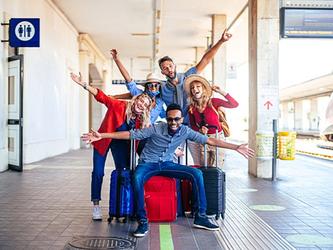Over it? Overtourism and post-pandemic travel
In March, city officials in Venice set up a control room on the island of Tronchetto, using mobile phone data to monitor the footfall of tourists around the city. By gathering information about visitors’ whereabouts – and where they come from – the authorities hope to use the data to tackle overtourism in the City of Bridges, which has between 26 million and 30 million visitors annually and a shrinking population of permanent residents.
But the issue isn’t confined to Venice alone, nor only to cities. In 2018, a report from the UN World Tourism Organization (UNWTO) said ‘overtourism’ can be defined as ‘the impact of tourism on a destination, or parts thereof, that excessively influences perceived quality of life of citizens and/or quality of visitors experiences in a negative way’.
The income from tourism is a significant contributor to national and local economies, but unsustainable tourism has become an international issue in recent years, not just in urban areas such as Venice, Barcelona and Edinburgh but also in destinations such as Peru’s Machu Picchu, the Isle of Skye and Iceland’s Golden Circle. The popularity of certain destinations leads to overcrowding and a strain on local infrastructure, and many countries and tourist boards are focusing their efforts on how to address it.
With international travel suppressed over the past year because of pandemic restrictions, many people have holidayed in their home countries, boosting the local economy in the UK and elsewhere.
The Scottish Tourism Index, compiled by 56 Degree Insight, measures the views and opinions of the Scottish population in relation to holiday-taking. The March 2021 wave of the survey found an overall increase in demand from Scots to take holidays within the country, with particularly high levels of demand to visit rural areas, specifically the Highlands.
In early 2020, the country’s tourist board, VisitScotland, published a guide to eco-friendly tourism, suggesting that visitors skip popular sites such as Edinburgh Castle altogether, and later launched a campaign urging visitors to be responsible, after the temporary lifting of lockdown restrictions resulted in increased visitor numbers in popular destinations.
Recovery mode
The thought of overcrowding may seem jarring at a time when visions of last year’s empty streets still linger in the memory, but as restrictions lift and the travel industry rebounds, now is the time to consider how to make destinations more sustainable, according to Caroline Bremner, head of travel research at Euromonitor International.
“Overtourism was very much an issue pre-Covid-19 and for now has been replaced with zero tourism. However, there is a high risk that visitor demand levels snap back to pre-crisis levels if destination marketing organisations and tourism boards don’t implement the right kinds of strategy or actions,” says Bremner.
“Many destinations are working with NGOs and non-profits such as the Global Sustainable Tourism Council, Future of Tourism Coalition, and the Travel Foundation to make the necessary sustainable transformation.”
New Zealand’s tourism minister has outlined plans to ‘reset’ tourism post-pandemic, including planning for fewer international visitors to the country and attempting to diversify the economies of towns that are dependent on tourism.
Sustainable tourism efforts often draw on regulation, such as restricting short-term rental accommodation. Technology can also help. In Barcelona, where the number of visitors is growing every year, a project by d-Lab, a programme of Mobile World Capital Barcelona, used mobile phone data and the internet of things to understand more about the activities and behaviour of tourists in the city, including at Gaudi’s Sagrada Familia basilica.
Berlin-based startup GetYourGuide aims to address the issue of congestion at popular attractions including the Louvre in Paris and New York’s Top of the Rock, using sensors and software designed to measure waiting times and occupancy levels in real time. This information is used to predict waiting times for visitors and for the attractions themselves through a mobile app.
Green credentials
Early in 2020, before the pandemic took hold, Sweden experienced a 4% drop in the number of people flying via its airports, as the country’s ‘flygskam’ or ‘flight shame’ movement gained prominence.
As awareness of the environmental impact of travel increases, is this likely to result in a change in behaviour that could address the issue of overtourism? And might the experience of local holidays encourage people to seek out the path less travelled in future?
In a survey from luxury travel network Virtuoso in April, 82% of respondents claimed the pandemic has made them want to travel ‘more responsibly’. When asked what they would be willing to do to help curb overtourism, 76% of respondents said they would visit a popular destination during an off-peak time of year.
Globally, there has been greater interest from consumers in less crowded locations, including short-term rentals, camping and alternative accommodation rather than urban locations, says Bremner.
Euromonitor’s Voice of the Consumer: Lifestyles Survey 2021 report found continued strong interest from consumers in having a positive impact on the environment through their daily actions (growing in 2021 to 66% of respondents).
However, Bremner says: “When it comes to selecting sustainable travel features (such as adventure, eco-tourism, voluntourism, outdoors/nature-based activities), there is a disconnect, and 48.8% of consumers worldwide choose sustainable travel options, compared with 52.3% that select mass-market options, which are associated more with overtourism such as package holidays, city breaks, urban locations, arts and heritage, family holidays and group activities.”
Data from the Ipsos Global Advisor study, conducted between 19 February and 5 March for Earth Day, found that 26% of people claimed they would travel more for holidays that don’t require them to fly to a destination; but most ( 56%) plan to travel the same amount regardless of whether flying is involved.
The online survey, which is conducted monthly in 30 markets including Great Britain, the US, Germany and China, also found that 45% said they would likely avoid flying, but this willingness to try to live more sustainably hasn’t changed significantly in the past seven years.
According to Jessica Long, head of sustainability at Ipsos, this is largely because people feel that they are doing ‘enough’ and don’t feel the burden should be placed on individuals to make change.
“While concern for the environment remains at an all-time high, people ultimately feel they’re doing their fair share – and shouldn’t have to make significant sacrifices, as they feel they’re already doing enough. They want government to do heavy lifting – and, therefore, are less willing to make significant changes to lifestyle.”
- International tourists have increased from 25 million international arrivals in 1950, to more than 1.3 billion in 2017 (UNWTO)
- International tourist arrivals were down 83% in the first quarter of 2021 as travel restrictions remained in place (UNWTO)
- Amsterdam’s visitor numbers passed 20 million in 2018, doubling in 20 years
- In 2017, Unesco threatened to remove Dubrovnik’s World Heritage status owing to overcrowding.
THIS ARTICLE WAS FIRST PUBLISHED IN THE JULY ISSUE OF IMPACT.

We hope you enjoyed this article.
Research Live is published by MRS.
The Market Research Society (MRS) exists to promote and protect the research sector, showcasing how research delivers impact for businesses and government.
Members of MRS enjoy many benefits including tailoured policy guidance, discounts on training and conferences, and access to member-only content.
For example, there's an archive of winning case studies from over a decade of MRS Awards.
Find out more about the benefits of joining MRS here.













0 Comments